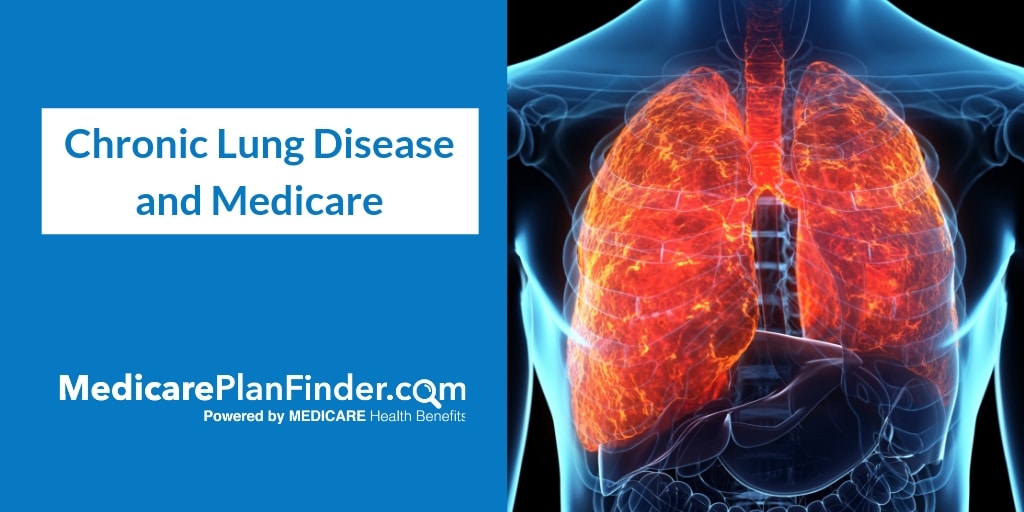
A Guide to Medicare Chronic Lung Disease Coverage
August 21, 2019Chronic lung diseases affect millions of people in the United States. It falls under the fourth leading cause of death. Thankfully, the Centers for Medicare & Medicaid Services (CMS) considers chronic lung disorders to be one of the qualifications for a Medicare Special Needs Plan.
As you age, it’s easy to brush off symptoms as “part of the aging process.” You might even purposely ignore certain symptoms because they “aren’t that bad,” and you don’t want to pay for treatment – but your symptoms could be indicative of a bigger problem and should not be taken lightly.
If you are diagnosed with chronic lung disease, you may qualify for a Medicare Special Needs Plan that can save you thousands of dollars in doctor visits and treatment costs. Qualifying for a Special Needs Plan means you will also qualify for a Special Enrollment Period, which allows you to change plans more often.
Let’s take a look at what all of this might mean for you.
What Is Chronic Lung Disease?

Chronic lung disease refers to any condition that causes long-term obstructions to a person’s airways. They can cause the following symptoms:
- Shortness of breath after little or no physical exertion, or shortness of breath after normal exercise plus a brief rest period
- A persistent cough – one that lasts longer than a month
- Mucus or sputum production lasting a month or longer
- Labored breathing
- Swollen feet, ankles or legs
- Blue lips
If you experience any of these symptoms, you should talk to your doctor immediately. Chronic lung disease can severely impact your quality of life and shorten your lifespan considerably. The faster you get started on treatment, the better.
SEP-Qualifying Disabilities
To qualify for a SEP (Special Enrollment Period) due to a disability or disease, your condition must be “severe or disabling.” The list of chronic lung diseases below would automatically qualify you for a SEP because you would be eligible for a Medicare Special Needs Plan, or SNP.
Once you qualify for a Special Enrollment Period, you won’t be restricted to the Annual Enrollment Period (AEP) anymore.
Usually, AEP is the only time of year that Medicare beneficiaries can switch Medicare Advantage plans. It only lasts from October 15 through December 7. Those with a SEP are eligible to make one change per quarter (January – March, April – June, July – September). The fourth quarter is excluded because you’ll be able to switch like everyone else from October 15 through December 7 (the Annual Enrollment Period).
Chronic Lung Diseases List
The Centers for Medicare & Medicaid Services (CMS) specifically defines the following lung disorders as chronic lung diseases that could make you eligible for a Medicare Special Needs Plan:
- Asthma
- Chronic bronchitis
- Emphysema
- Pulmonary fibrosis (PF)
- Pulmonary hypertension
Lung cancer is a qualifier as well (though it is listed in the “cancer” category instead of “chronic lung disorders.”
Severe COPD as a Qualifying Disease
You might be wondering, “what about severe COPD? Does Medicare cover COPD?” Medicare Part B can cover COPD diagnosis and treatment.
To begin, Medicare Part B covers your doctor’s visits at 80%. Start by asking your doctor about COPD and getting tested. Then, Part B also will cover a comprehensive pulmonary rehabilitation program for moderate to severe COPD (chronic obstructive pulmonary disease). If your doctor offers this treatment, you will only owe 20% of the Medicare-approved amount with Part B (after the Part B deductible). If you are hospitalized, your treatment will fall under Part A, and you may owe a hospital copayment.
Emphysema and bronchitis are forms of COPD, so a COPD diagnosis may mean that you also qualify for a Special Needs Plan (SNP) and a Special Enrollment Period. In that case, you may be able to get even more coverage.
SNP plans often come with care coordination. That means no more confusing phone calls and mixed messages between all your different doctors!f
What Chronic Lung Disease Treatments Will Medicare Cover for COPD?
Two main diseases fall under the term COPD: chronic bronchitis and emphysema. There currently is no cure for COPD. Early detection can help you manage your symptoms and continue to live a “normal” life with COPD.
One of the main things to keep in mind when living with COPD is that seemingly small things like seasonal allergies or air pollution can cause serious exacerbations. It’s important to take every small infection or symptom seriously.
COPD Oxygen Therapy
People with COPD may have low blood oxygen levels, which is called hypoxia. Supplemental oxygen, or oxygen therapy, can help prevent heart failure and improve quality of life in COPD patients.
Some people may need long-term oxygen therapy 24 hours per day. Others may only need supplemental oxygen during exercise, sleep, or air travel.
You can get oxygen therapy in three ways:
- Oxygen concentrators
- Oxygen-gas cylinders
- Liquid-oxygen devices
Remember that you cannot smoke or stay near an open flame while using any of these devices.
Medicare Part B will cover your device as well as any accessories (like mouthpieces or tubing), maintenance, repairs, and the oxygen itself. You will only be responsible for 20% of the costs with Part B.
Uniquely, Medicare requires a five-year obligation with whichever company you use to rent your oxygen equipment. After five years, you will be able to rent new oxygen equipment from a separate provider.
COPD Prescription Drugs with Medicare Health Insurance
While no prescription can cure COPD, there are several that can help you manage your discomfort. Some examples may include:
- Bronchodilators (in an inhaler; relaxes the airway muscles)
- Inhaled steroids (reduce inflammation)
- Phosphodiesterase-4 inhibitors (reduces inflammation and relaxes the airway muscles)
- Theophylline (eases breathing)
To get coverage for these drugs, you’ll need either a Medicare Part D plan or a Medicare Advantage plan with prescription drug coverage.

COPD Surgery
Sometimes, when patients have severe emphysema or severe COPD, doctors may recommend surgery. There are three COPD surgeries:
- Lung Volume Reduction: Small portions of damaged tissue are removed from the upper lungs, creating extra space so that your diaphragm is more productive. The procedure is minimally invasive. A small valve is placed in the lung.
- Bullectomy: Bullae (large air spaces) are removed from the lungs to improve airflow.
- Lung Transplant: A lung transplant comes with huge risks, but can also have huge rewards. This procedure requires that you meet specific criteria outlined by your doctor. After a lung transplant, you’ll need to take immune-suppressing medications for the rest of your life.
Medicare coverage for your surgery would fall under Part A, but you’ll still have copayments and a deductible. Some Medicare Advantage plans might provide more coverage.
COPD and Medicare Supplement
A Medicare Supplement (also called Medigap) plan can be a great way to cover the extra costs associated with COPD. However, most people will find that a Medicare Advantage plan is better for COPD than a Medicare Supplement. That’s because you cannot be denied for Medicare Advantage based on preexisting conditions. However, you can be denied Medicare Supplement coverage.
There are two times when you can get a Medicare Supplement plan without medical underwriting. One is when you’re signing up for Medicare health insurance for the first time, and the other is if you lose your current coverage due to no fault of your own and need a new plan.
Lung Cancer Screenings
If you’ve been diagnosed with COPD, your doctor may recommend annual lung cancer screenings, because about one percent of COPD patients develop lung cancer. Medicare Part B covers yearly lung cancer screenings with Low-Dose Computed Tomography (LDCT) if you meet one or more of the following conditions:
- You’re 55-77 years old
- You don’t display any lung cancer symptoms
- You smoke currently or quit smoking within the past 15 years
- In the past, you smoked at least one pack per day for 30 years
- A doctor orders the screening
Inhalers Medicare Will Cover
In many cases, inhalers will fall under prescription coverage (meaning you will need either a Part D prescription drug plan or a Medicare Advantage plan that includes prescription benefits). However, your inhaler may be considered “durable medical equipment,” which is covered by Part B. There are two COPD inhalers covered by Medicare Part B: controllers and rescue relievers.
Controllers: A doctor may prescribe this type of inhaler to help keep your symptoms from worsening. Different types of controllers are:
- Short-acting Anticholinergic Bronchodilators
- Long-acting Anticholinergic Bronchodilators
- Corticosteroids
- Phosphodiesterase-4 Inhibitor (PDE-4 Inhibitor)
- Combinations of Corticosteroids and Long-acting Beta-agonists
- Combinations of Long-Anticholinergic Bronchodilators and Corticosteroids
Rescue Relievers: These inhalers are reserved for emergencies for fast, short-term symptom relief. Different types of rescue relievers are:
- Short-acting Beta-agonist Bronchodilators
- Combinations of Short-acting Anticholinergic and Short-acting Beta-agonist
The right inhalers can help keep your day-to-day symptoms at bay and step in when a flare-up occurs. Your doctor will be able to help you get the right prescription medications and inhalers for you.
Does Medicare Part D Cover COPD Inhalers?
Medicare Part D plans can cover COPD inhalers (bronchodilators and steroids), but there may be some cost-sharing required. One study found that out-of-pocket annual costs for inhalers with a Part D benefit ranged from $494 to $1,197 in 2015.
It’s important to speak to an insurance agent before you invest in Medicare Part D because there may be cheaper plans out there, or you may qualify for savings that you don’t even know about. You can get in touch with an agent by calling 844-431-1832.
What Treatments Will Medicare Cover if I Have Lung Cancer?

Along with initial lung cancer screening, Medicare will cover certain cancer treatments. Different Original Medicare treatments and services fall under Parts A and B.
Part A:
- Hospital visits and stays, including the treatment you receive while staying at the hospital while you’re considered an inpatient. Note: You can still be considered an outpatient while you stay at the hospital if you’re considered to be on “observation status.”
- Care at skilled nursing facilities following a three-day hospital stay
- Limited home health care
- Hospice
Part B:
- Visits to doctors’ offices
- Many chemotherapy drugs administered intravenously in a doctor’s office or outpatient clinic
- Some oral chemotherapy drugs
- In some cases, Medicare will cover second opinions for non-emergency surgeries, and even third opinions if the first two opinions differ.
Medicare can help cover your lung cancer screening and treatment so you can be in the best health possible. A qualified professional can help you determine which plan will cover what you need while taking your budget and lifestyle into consideration.
Does Medicare Cover Pulmonary Rehabilitation?
People with COPD, pulmonary hypertension, interstitial lung disease, cystic fibrosis, and those who have had a lung transplant can all benefit from pulmonary rehabilitation, also called respiratory therapy.
A pulmonary rehabilitation program includes both education and exercise to help you manage your breathing and increase your stamina. It may also include testing to find out if oxygen supplements would help you.
You’ll meet with a medical professional two or three times per week for a few months in a hospital outpatient setting. During that time, you’ll complete exercises like stretching, weight lifting, walking, and cycling. The staff member assisting you will walk you through each step of the process. Since the goal is pulmonary rehabilitation (not weight loss), everything will be focused on your breathing and stamina.
Since pulmonary rehabilitation programs usually occur in hospital outpatient settings, your Medicare coverage will fall under Part A. You will likely owe the hospital a copayment for each session. In some cases, your rehabilitation might occur in a doctor’s office instead, in which case it would fall under Part B, and you would owe 20%. To get your Medicare coverage for this service, you will need a direct referral from a doctor. If you qualify for both Medicare and Medicaid, this service might fall under your state’s Medicaid physical therapy coverage.
How many visits does Medicare cover for pulmonary rehab?
The CMS Medicare guidelines for pulmonary rehab state that “Medicare will pay for up to two (2) one-hour sessions per day, for up to 36 lifetime sessions (in some cases, up to 72 lifetime sessions) of PR.” To qualify, your care must take place within one of the qualified pulmonary rehab centers that your doctor refers you to.
Does Medicare Cover COPD Prevention?
The number one cause of COPD is overexposure to lung irritants like cigarette smoke, pipes, cigars, air pollution, and chemical fumes. It is possible to achieve overexposure purely from second-hand smoke.
In some rare cases, COPD can also come from a genetic condition called “alpha-1 antitrypsin deficiency.” The condition refers to low blood levels of alpha-1 antitrypsin, a protein from the liver. Additionally, some people with asthma develop COPD.
The best way to prevent COPD is to avoid smoke and harmful chemicals. However, if you fear you may have already been exposed, some Medicare-covered services may help you prevent further damage.
To begin, you may wonder what tests are covered by Medicare. You can ask your doctor for a pulmonary function test. Your doctor will use either spirometry or plethysmography, both of which are noninvasive. Both tests have a mouthpiece that will measure your breathing; the difference is that a plethysmography can test for lung residual volume and total lung capacity, while spirometries cannot. Since these tests are not medically necessary, Original Medicare does not cover spirometry, but your private plan may. Regardless, spirometries can cost less than $100 out of pocket. Medicare will cover a plethysmograph when your doctor deems it necessary.
No matter what your test results are, you can prevent COPD exacerbation by getting your annual flu shot, which would be covered at your doctor’s office under Part B.
COPD Services, Medications, and Treatments That Medicare Does Not Cover
It’s important to recognize that Original Medicare (Parts A and B) does not cover prescription drugs. While some of your inhalers may be covered under Part B, any other drugs related to your COPD treatment will not be covered. For prescriptions, you’ll need to choose between either a Medicare Advantage plan that includes a prescription benefit or a Part D prescription drug plan. You cannot have both a Medicare Advantage plan and a Part D plan at the same time, so you’ll have to choose one or the other.
One exception is that if you have a lung transplant, Medicare Part B will continue to cover your immunosuppressant drugs as long as you had Medicare Part A at the time of transplant. If you did not yet have Medicare when you received your transplant, you may need to seek alternative drug coverage through a Part D plan or certain Medicare Advantage plan to get coverage for your immunosuppressants.
Additionally, Medicare will not cover experimental treatments or drugs.
What to Do if Medicare Won’t Cover the COPD Drugs, Treatments, and Services You Need
If you’re finding that Medicare either does not cover the COPD services you need or does not cover them enough, it might be time to look into a form of Medicare extended coverage. COPD patients and anyone with chronic lung disease symptoms may find that Medicare Advantage Prescription Drug plans and Medicare Supplements (two types of private Medicare plans) are worth the investment – but you can’t have both types.
Remember that if you are diagnosed with chronic lung disease, you may be eligible for a Special Needs Plan. In turn, you’d be eligible for a Special Enrollment Period (meaning you don’t have to wait until the fall to change plans).
A Medicare Supplement plan (Medigap) can help you by covering those pesky deductibles, copayments, and other charges related to your Medicare coverage. For example, Medigap Plan G covers hospital coinsurance and copayments. It’s a great plan choice for anyone preparing for surgery or an extended hospital stay.
A Medicare Advantage Prescription Drug plan can help you with your COPD by providing the prescription drug coverage you need. Some of these plans might also cover additional therapy sessions, extra surgery coverage, etc. Each plan is different, so it’s a good idea to speak with an insurance agent who understands all of your available options.
COPD patients might also qualify for a Medicare Advantage Special Needs Plan, a type of Medicare Advantage that is specifically designed for your needs and may provide additional benefits.
To speak with an insurance agent in your area for free, call 844-431-1832. You can also start by using our Medicare plan search tool.
Get Coverage for Your Condition
Chronic lung disease is not something that should be taken lightly. If you think you might qualify for a Special Enrollment Period with your condition, call Medicare Plan Finder at 844-431-1832 or contact us here today. We can help you determine your Medicare status and find the right plan to suit your budget and lifestyle.


